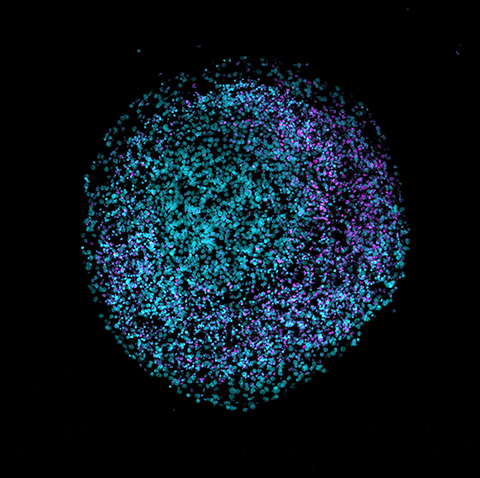From the journals: MCP
Among cells, communication is key. Silence of the peptide ions, Mapping the estrogen receptor interactome. Read about papers on these topics recently published in the journal Molecular & Cellular Proteomics.
Among cells, communication is key

Effective cell-to-cell communication is a complex crosstalk crucial for forming and maintaining healthy tissues. Events that disrupt these lines of communication can lead to diseases, such as certain cancers and inadequate tissue repair after cardiac arrest. Wei Wu of the Singapore Immunology Network and the Agency for Science, Technology and Research and Jeroen Krijgsveld of the German Cancer Research Center detailed the value of understanding cellular protein secretion and cellular modes of communication in a perspective in the journal Molecular & Cellular Proteomics. Scientists lack a full understanding of the secretome, the repertoire of molecules that facilitate cellular cross talk. Therefore, the authors concluded more research is needed to define all the molecules essential for cellular communication.
The researchers discussed strategies and model systems that are effective in understanding the protein language of cells. Some of these include cellular co-culture approaches, chemical biology tools, protein enrichment and proteomic and computational methods. Moreover, the complexity of studying the secretome is compounded by how different cells secrete proteins into the extracellular space, such as via extracellular vesicles, endoplasmic reticulum–Golgi classical secretion and nonclassical secretion mechanisms. Nonclassically secreted proteins lack signal peptides, which make them difficult to identify using conventional proteomics methods. Krijgsveld and Wu emphasized that the reliability of a given secretome dataset is based on accurate representation. The higher the proportion of annotated secreted proteins using curated database information; the more representative the secretome. The authors noted that cell type, post-translational modifications and experimental conditions all affect the difficulty of studying the secretome.
Silence of the peptide ions
Mass spectrometry, or MS, is a powerful analytical tool, which when used in proteomics, can reveal qualitative and quantitative information about the proteins that make up the proteome. Multiplex proteomics simultaneously analyses and compares multiple proteomes in a single mass spectrometric assay. However, this method produces errors in peptide quantification due to ion interference, a phenomenon that occurs when peptide ions with similar mass as the target peptide are coisolated in the mass spectrometer. This coisolation can lead to a suppression of quantitative differences and to a misinterpretation of the results.
To address these inaccuracies, Moritz Madern of the University of Vienna and a team of researchers developed a computational method based on regression modelling to accurately predict and correct reporter ion interference in any multiplex proteomics dataset. Their work was published in the journal Molecular & Cellular Proteomics. The authors showed that their strategy could lead to improved quantitative accuracy in multiplex proteomics experiments.
Mapping the estrogen receptor interactome
The National Cancer Institute estimates that estrogen receptor, or ER, positive breast cancer accounts for 70% of all human breast cancers. Specific mutations of ERα, one of the main ERs, can disrupt its regulation and lead to cellular oncogenesis and resistance to treatments such as aromatase inhibitors. This class of drugs is one of the most common hormone therapy drugs used to treat Erα+ breast cancers, and they act by limiting tumor oestrogen, a hormone growth factor for ERα+ breast cancer. Understanding how tumor cells regulate ERα expression is key to designing an appropriate treatment plan.
In a recent study, Camilla Rega at the Institute of Cancer Research, London, and a team of researchers used a novel antibody-based proximity labelling, or PL, approach, coupled with mass spectrometry to investigate the ERα protein network, or interactome. This work was published in the journal Molecular & Cellular Proteomics. Using this approach, they detected most of the known ERα protein interactors in breast cancer cells. The authors also identified that several ERα interactors had undergone modifications, such as sumoylation and ubiquitination, which makes them difficult to detect using conventional methods. This antibody-based PL approach may lead to refinement of the chemotherapeutic agents used to treat ERα+ breast cancer.
Enjoy reading ASBMB Today?
Become a member to receive the print edition four times a year and the digital edition monthly.
Learn moreGet the latest from ASBMB Today
Enter your email address, and we’ll send you a weekly email with recent articles, interviews and more.
Latest in Science
Science highlights or most popular articles

The science of staying strong
Muscles power every movement, but they also tell the story of aging itself. Scientists are uncovering how strength fades, why some species resist it and what lifestyle and molecular clues could help preserve muscle health for life.

Bacteriophage protein could make queso fresco safer
Researchers characterized the structure and function of PlyP100, a bacteriophage protein that shows promise as a food-safe antimicrobial for preventing Listeria monocytogenes growth in fresh cheeses.

Building the blueprint to block HIV
Wesley Sundquist will present his work on the HIV capsid and revolutionary drug, Lenacapavir, at the ASBMB Annual Meeting, March 7–10, in Maryland.

Gut microbes hijack cancer pathway in high-fat diets
Researchers at the Feinstein Institutes for Medical Research found that a high-fat diet increases ammonia-producing bacteria in the gut microbiome of mice, which in turn disrupts TGF-β signaling and promotes colorectal cancer.

Mapping fentanyl’s cellular footprint
Using a new imaging method, researchers at State University of New York at Buffalo traced fentanyl’s effects inside brain immune cells, revealing how the drug alters lipid droplets, pointing to new paths for addiction diagnostics.

Designing life’s building blocks with AI
Tanja Kortemme, a professor at the University of California, San Francisco, will discuss her research using computational biology to engineer proteins at the 2026 ASBMB Annual Meeting.

